views
Flight Schools and Aviation Academies
Introduction
In an era where air travel is not just a luxury but a global necessity, the demand for skilled pilots and aviation professionals continues to soar. Whether aspiring to captain a commercial airliner or operate private aircraft, flight schools and aviation academies serve as the crucial training grounds for the next generation of aviators. These institutions blend theoretical knowledge with hands-on experience, creating a structured path to the cockpit.
Understanding Flight Training Institutions
Flight schools and aviation academies are educational institutions dedicated to preparing individuals for careers in aviation. They offer a range of programs — from private pilot licenses (PPL) to commercial pilot training (CPL), and often include advanced certifications such as airline transport pilot licenses (ATPL).
There are generally two types of flight schools:
Part 61 Schools (common in the U.S.): More flexible and often tailored to individual pacing.
Part 141 Schools: Follow a stricter FAA-approved syllabus with faster training, ideal for full-time students.
Outside the U.S., equivalent regulatory frameworks are used, such as EASA in Europe or DGCA in India.
Curriculum and Training Components
Aviation academies typically divide training into two core components:
Ground School
This covers theoretical knowledge such as:
Aerodynamics
Meteorology
Navigation
Aviation law and regulations
Aircraft systems and operations
Flight Training
Practical experience includes:
Maneuvering and handling aircraft
Takeoffs and landings
Instrument flying
Cross-country flights
Emergency procedures
Flight simulators are also widely used to supplement training in a safe and controlled environment.

Choosing the Right School
Selecting a flight school involves careful consideration. Key factors include:
Accreditation and approvals from aviation authorities
Fleet size and aircraft condition
Instructor qualifications
Graduate placement rates
Cost of training and financing options
Location and weather conditions (more clear flying days = more practice)
Additionally, some academies have partnerships with airlines, providing a fast track to employment after graduation.
Career Opportunities in Aviation
Completing training at a flight school opens doors to a wide array of careers:
Commercial airline pilot
Charter/private pilot
Cargo or freight aviation
Flight instructor
Agricultural, medical, or firefighting pilot
Corporate or executive aviation
With global aviation set to grow, the demand for trained pilots and aviation professionals remains high, particularly in regions like Asia and the Middle East.
Challenges and Considerations
While aviation is a rewarding field, it comes with challenges:
High cost of training
Intense time commitment
Medical and psychological demands
Changing regulatory and safety standards
It’s crucial for aspiring pilots to approach the profession with dedication, discipline, and a clear understanding of what the career entails.
Conclusion
Flight schools and aviation academies are more than just educational institutions — they are the launchpads for aviation dreams. With the right mindset, training, and support, students can take off on a career that combines technical skill, adventure, and global opportunity. As the aviation industry continues to expand, the skies are wide open for those ready to soar.










